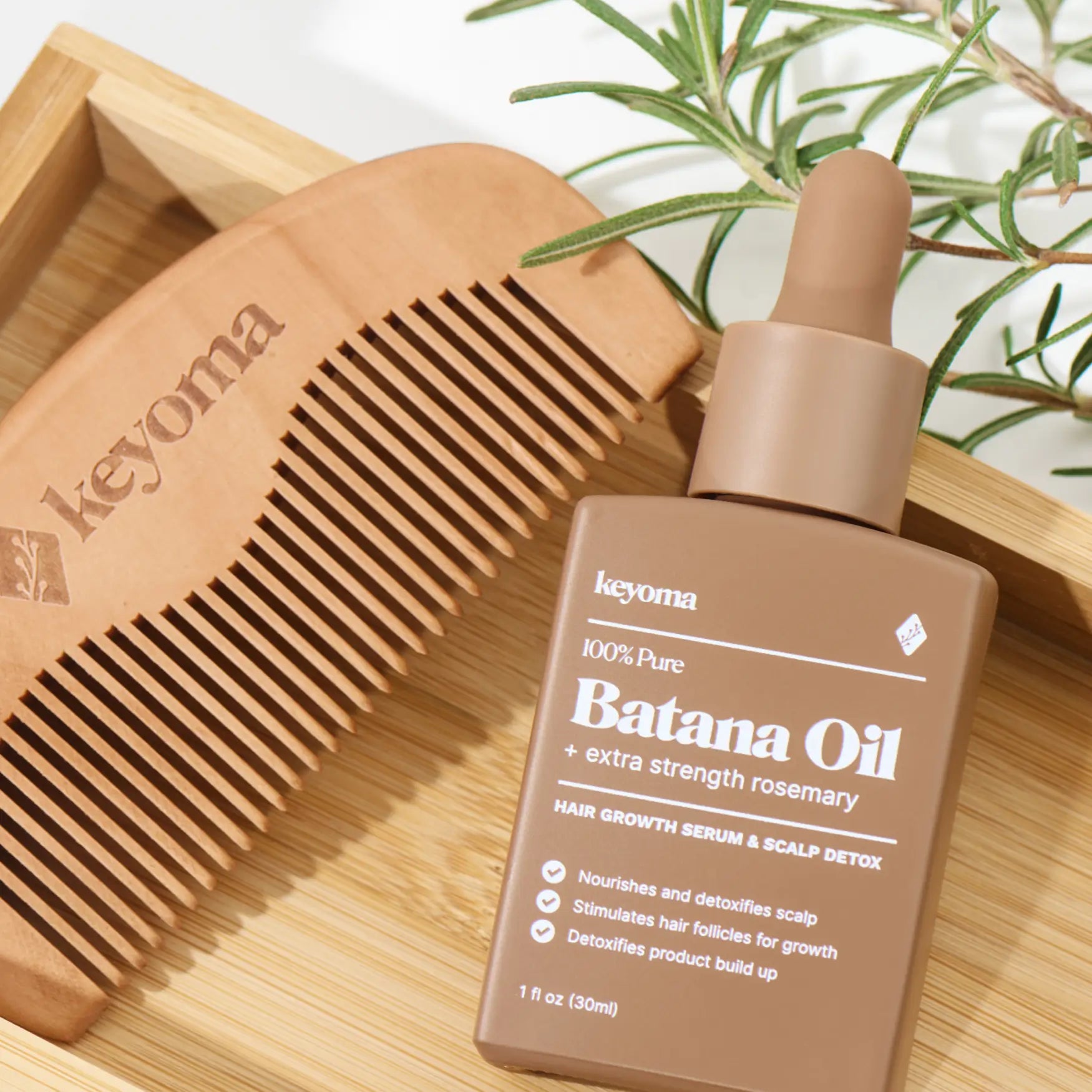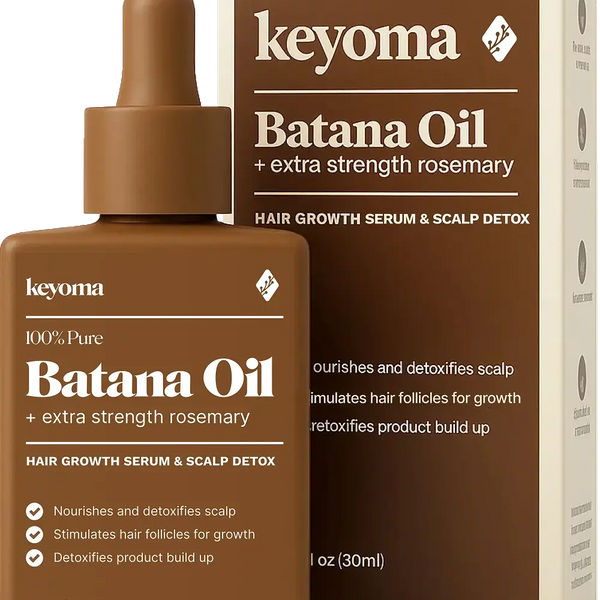Last updated
May 13, 2025
¿De qué está hecho el aceite de Batana? Origen, proceso y beneficios para el crecimiento del cabello
Published on
May 13, 2025

In this article
Te preocupas por lo que toca tu cuero cabelludo, y deberías hacerlo.
El aceite de batana no es una moda pasajera. Proviene del fruto de la palma aceitera americana y se prensa a mano con métodos de eficacia comprobada. En pueblos de Honduras, las familias han transmitido esta práctica para ayudar a restaurar el cabello debilitado.
Confiamos en su pureza y su reputación de larga data para respaldar resultados reales.
Si leer las listas de ingredientes le hace sentir como decodificar un informe de laboratorio, es posible que este sea el lugar donde finalmente deje de buscar.
¿De dónde proviene el aceite de Batana?
El aceite de Batana proviene del fruto de la palma aceitera americana , que crece de forma natural en América Central y del Sur.
Las formas más confiables se elaboran a mano en La Mosquitia, una zona remota del este de Honduras. Aquí, familias misquitas recolectan la fruta, extraen la pulpa y la cocinan lentamente hasta que el aceite sube. Esto no se hace en fábricas ni con máquinas, sino por personas que lo han hecho de la misma manera durante décadas.
Estás utilizando algo que ha pasado de generación en generación, no algo que se ha producido en una cadena de montaje.
¿Cómo se elabora el aceite de Batana?
El aceite de Batana se elabora mediante métodos ancestrales que ayudan a proteger sus nutrientes naturales y a mantenerlo limpio.
Quizás te preguntes cómo un solo ingrediente puede marcar la diferencia. La respuesta está en su elaboración. Cada paso está diseñado para conservar intactas las propiedades naturales de la fruta sin añadir nada artificial.

Recibes el valor completo de la planta. No se extrae nada. No se añade nada extra.
Paso 1: Cosecha de la fruta
El trabajo comienza en lo profundo de los bosques de Honduras. Los recolectores misquitos locales caminan entre la espesura de los árboles para recolectar a mano la fruta madura de las palmas aceiteras estadounidenses. Estos árboles crecen sin químicos ni agricultura comercial, lo que ayuda a mantener el aceite limpio y prácticamente en su estado natural.
Paso 2: Tostar y machacar
Tras la recolección, la fruta se tuesta a fuego abierto. El calor ablanda la pulpa y facilita la extracción del aceite. Cuando la fruta se enfría, se machaca a mano hasta obtener una pasta densa y suave.
Este paso ayuda a conservar los nutrientes del aceite mientras lo prepara para una cocción suave.
Paso 3: Cocción lenta
La fruta machacada se vierte en ollas grandes y se cocina lentamente a fuego de leña. El calor constante ayuda a extraer el aceite sin afectar sus nutrientes. A medida que el aceite sube a la superficie, se retira suavemente a mano.
Mucha gente no se apresura en esta parte. Toma tiempo, pero ayuda a mantener los beneficios del aceite justo donde los desea.
Paso 4: Filtrado y enfriamiento
El aceite se vierte a través de filtros finos para atrapar cualquier resto de pulpa. Este paso final ayuda a mantener una textura suave, conservando al mismo tiempo sus nutrientes naturales. Tras el filtrado, el aceite se enfría lentamente y se almacena en recipientes herméticos para conservar su frescura.
Esta parte es importante. Es lo que ayuda a que el aceite se mantenga limpio, eficaz y libre de cualquier componente artificial.
¿Qué hace que el aceite de Batana sea diferente de otros aceites?
El aceite de Batana se destaca porque se elabora lentamente, se mantiene puro y nunca se mezcla con rellenos sintéticos.

La mayoría de los aceites capilares disponibles hoy en día contienen químicos o ingredientes diluidos. El aceite de Batana es diferente. Se elabora en lotes pequeños mediante métodos heredados, no automatizados. Cada paso ayuda a conservar los nutrientes originales y evita los aditivos agresivos que pueden irritar el cuero cabelludo.
Quizás estés acostumbrado a las promesas en las etiquetas. Esta se basa en cómo se elabora y qué omite.
Origen y proceso de los ingredientes
El aceite de Batana proviene de palmas silvestres , no de fincas comerciales. Estas palmas crecen libremente en las selvas tropicales de Honduras. Nunca se fumigan ni se cosechan a la fuerza. Los recolectores locales recogen cada fruto a mano cuando está listo.
Las familias misquitas siguen un proceso lento y cuidadoso para convertir la fruta en aceite. No usan máquinas. No se apresuran. Mantienen cada paso lo más natural posible.
Pureza y calidad
El aceite de Batana se mantiene completamente crudo y sin refinar desde su elaboración hasta su entrega. No contiene conservantes sintéticos, fragancias añadidas ni rellenos innecesarios.
Cada gota conserva la esencia original de la fruta. Se prensa, se filtra y se deja intacta.
Resultados y rendimiento
Muchas personas que usan aceite de Batana notan que su cabello se siente más grueso y brillante después de usarlo regularmente. Ayuda a hidratar las fibras secas y puede calmar el cuero cabelludo irritado o tirante.
Quienes tienen piel sensible suelen optar por él porque no contiene aditivos agresivos que causan reacciones. Su fórmula simple y limpia lo convierte en una opción confiable cuando todo lo demás te deja con ganas de más.
Comparación con aceites comerciales
Muchos aceites capilares comerciales contienen siliconas, rellenos o mezclas sintéticas que se quedan en el cabello en lugar de cuidarlo. Estos ingredientes pueden dar un brillo rápido, pero con el tiempo suelen acumularse y causar sequedad difícil de solucionar.
El aceite de Batana es diferente. Está repleto de nutrientes , se usa en su forma concentrada y está formulado para cuidar el cuero cabelludo en lugar de disimular el daño. Un solo ingrediente. Un resultado claro: un cabello con un aspecto más fuerte y una mejor sensación.
¿Por qué la gente usa aceite de Batana para el crecimiento del cabello?
El aceite de Batana favorece el crecimiento del cabello fino nutriendo el cuero cabelludo con nutrientes reales de origen vegetal.
La caída del cabello causada por el estrés, los cambios posparto o la edad puede frustrarte. Este aceite ayuda aportando ácido oleico y tocoferoles, dos compuestos naturales que fortalecen los folículos y reducen la rotura con el tiempo.

También ayuda a calmar la irritación con sus propiedades antioxidantes y antiinflamatorias, dándole a tu cuero cabelludo un espacio más limpio para crecer.
No estás estancado. Le estás dando a tu cabello una mejor oportunidad de crecer de nuevo.
Preguntas frecuentes
¿De qué está hecho el aceite de Batana?
El aceite de batana se elabora a partir del fruto de la palma aceitera americana. Se extrae la pulpa, se cuece lentamente y se filtra para obtener un aceite rico en nutrientes que se utiliza para el cuidado del cabello y el cuero cabelludo.
¿El aceite de Batana es bueno para el cabello?
El aceite de Batana es bueno para el cabello porque fortalece las fibras, favorece la salud del cuero cabelludo y aporta brillo natural. Su rico perfil nutricional ayuda a mejorar la textura del cabello sin usar químicos agresivos. ¿Cómo se usa el aceite de Batana en el cabello?
¿Puede el aceite de Batana hacer crecer el cabello?
El aceite de batana puede favorecer el crecimiento del cabello nutriendo el cuero cabelludo y fortaleciendo los folículos. Contiene compuestos naturales como el ácido oleico y los tocoferoles, que ayudan a reparar el daño y promueven un crecimiento saludable a largo plazo.
¿El aceite de Batana es lo mismo que el aceite de palma?
El aceite de batana no es lo mismo que el aceite de palma. El aceite de batana proviene de la palma aceitera americana (Elaeis oleifera), mientras que la mayor parte del aceite de palma se deriva de la palma aceitera africana (Elaeis guineensis). Difieren en origen, procesamiento y uso: el aceite de batana se elabora artesanalmente y se utiliza para el cuidado del cabello y la piel, mientras que el aceite de palma se produce en masa para la alimentación y productos industriales.
¿Cómo sé si mi aceite de Batana es real?
Puedes saber si tu aceite de Batana es auténtico comprobando su color, textura y aroma. El aceite de Batana auténtico tiene un color marrón intenso, una consistencia espesa y un aroma terroso y ahumado. Proviene de lotes pequeños y no contiene fragancias, colorantes ni conservantes sintéticos añadidos.
¿Listo para probar lo real?
Ya viste lo que hace diferente al aceite Batana. Ahora te toca sentir la diferencia.
Dale a tu cabello algo auténtico. Sin rellenos. Sin falsas promesas. Un solo ingrediente: hecho a mano, de confianza de generaciones.
Usted merece un producto que trabaje con su cuerpo, no contra él.
Compre aceite de Batana 100% puro y comience su viaje de recrecimiento hoy mismo.
Featured Product
100% Pure Batana Oil + Rosemary
Obtenga más información sobre el aceite de Batana
Tu carrito
Su carrito está actualmente vacío
Podría gustarte...
Buscar en nuestra tienda








